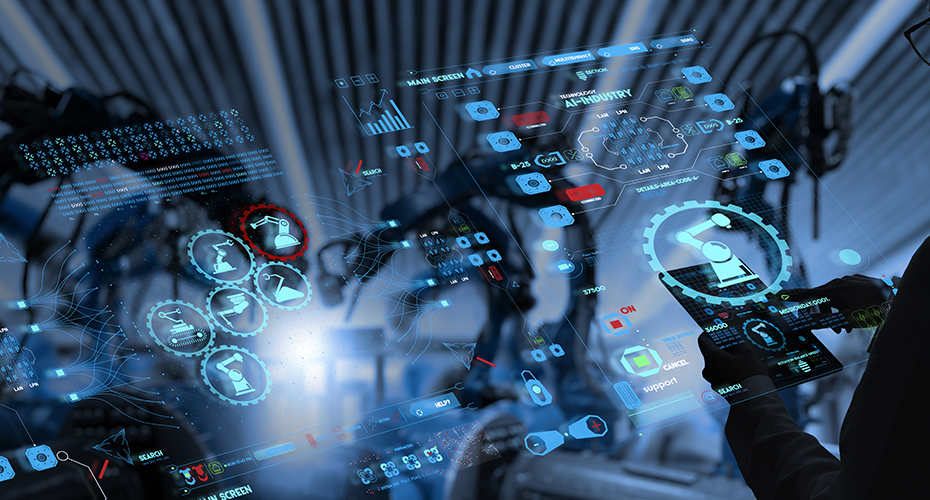
What is Hyperautomation?

Hyperautomation is listed as the 7th strategic technology trend of 2022. But what is it really? Let’s take the “hype” out of Hyperautomation! It was Gartner, in 2020, who actually coined this term. Hyperautomation is a disciplined, business-driven approach to rapidly identify, vet, and automate as many business and IT processes as possible. Leveraging an infrastructure of advanced technologies used to scale automation capabilities in an organization, hyperautomation further automates already automated processes.
Multiple technologies are often adopted in order to achieve hyperautomation, including:
- Artificial intelligence (AI)
- Machine learning
- Natural language processing (NLP)
- Robotic process automation (RPA)
- Business process management (BPM) and intelligent business process management suites (iBPMS)
- Other types of decision, process, and task automation tools
Combining RPA and AI technologies allows organization to automate where automation was never possible before: undocumented processes that rely on unstructured data inputs, and even new processes that were not feasible without automation.
Competitive Advantages of Hyperautomation
Hyperautomation allows organizations to:
- Realize Savings
Gartner expects that by 2024, organizations will lower operational costs by 30% by combining hyperautomation technologies with redesigned operational processes.
- Gain Faster Cycle Times
Faster time to market means the ability to meet ongoing consumer demand.
- Increase Productivity
Hyperautomation enables employees to focus on tasks that bring increased value to the organization. Employee morale also increases as employees don’t have to focus on mundane, repetitive tasks.
- Make Efficient Decisions
Hyperautomation and AI enable organizations to make more sound business decisions. The ability to analyze data in a quicker, more efficient manner helps to drive business, meeting goals across the organization.
- Integrate
Legacy systems can impede connectivity and collaboration. However, hyperautomation gives organizations the ability to integrate digital technologies across legacy systems.
- Achieve Business Agility and Flexibility
As organizations move past their reliance on a single technology for automation and focus on hyperautomation technologies, they are greater equipped to achieve a higher degree of scalability and flexibility.
- Improve ROI
Hyperautomation aids organizations in boosting revenue and reducing costs. Utilizing multiple technologies and tools, organizations can optimize their workflows. Gone are the days of hunting for two or three RPA use cases.
Hyperautomation vs Robotic Process Automation
With it being such a new concept, it’s important to make the distinction between hyperautomation and RPA. Hyperautomation uses multiple tools or platforms including RPA to scale automaton initiatives. It can be helpful to think of RPA as a subcategory of hyperautomation. While hyperautomation encapsulates the entire spectrum of automation-enabled technologies, RPA is just one aspect of it, amongst others like AI, NLP, BPMs, and iBPMs.
Industry Examples and Use cases
The recognized benefits of hyperautomation are the reasons many industries are jumping onboard this technology trend. Hyperautomation is not specific to a single industry. Multiple industries are capitalizing on hyperautomation technologies to improve both employee and customer experiences. As hyperautomation gains acceptance, industries are harnessing its power and realizing increased efficiency and lower operational costs within their businesses. An added benefit of hyperautomation is that industries can customize solutions for their specific needs utilizing multiple tools and platforms, enriching both employee and customer experiences along the way.
Healthcare
Hyperautomation is used in healthcare for payers, providers, and both patient and business processes. On the patient side, it’s about improving the overall experience, essentially making treatment plans and interactions easier. With the amount of personal data exchanged in healthcare, quality control and regulatory compliance are two main issues hyperautomation addresses on the business side. How many of us have not spent 10 to even 15 minutes checking into a medical office with the person behind the desk typing in our information, often multiple times in multiple systems to confirm our insurance, waivers, and history? And each of these tasks are repetitive, rules-based steps perfect for a digital assistant.
Use cases:
- Patient scheduling
- Documentation
- Research and development
- Regulatory compliance
- Coding and billing
- Processing of health insurance
- Processing standardization
- Drug procurement
- Inventory management
Banking and Finance Industry
From back-end processes to customer support, hyperautomation helps to ensure banking and finance operations run smoothly; reducing costs, safeguarding against fractures in regulatory compliance, reducing errors, increasing productivity, and building a better customer experience. Hyperautomation also helps to promote a healthier, more enriched employee experience. Free from mundane tasks that can be performed by machines, employees can focus on other more important areas of their jobs that drive business and further enhance the customer experience.
Use cases:
Customer service; Provide AI solutions to customers to make financial decisions
- Marketing and sales
- Customer onboarding
- Back-office process automation
- Banking services
- Regulatory reporting
- Lending services
- Enterprise support
- Fraud detection
Retail
The COVID-19 pandemic displayed the importance of using hyperautomation to support e-commerce. During this period, shoppers increasingly leaned on e-commerce for their everyday needs, heightening corporate awareness for efficient order processing systems. Hyperautomation plays a key role in both back-end and front-end processes. Having highly efficient inventory and customer management systems allows retailers to fulfill expectations. Utilizing AI enables retailers to analyze customer shopping patterns, which in turn allows them to make better business decisions regarding marketing, customer loyalty programs, and advertising to help generate additional revenue.
Use cases:
- Forecasting customer demands
- Product development
- Store planning
- Sales audits
- Accounting
- Tracking
- Customer analysis
- Inventory management
- Procurement
Hyperautomaton: A Trend Set to Last
Just how popular is hyperautomation? Gartner predicts the worldwide hyperautomation-enabling software market will reach nearly $600 billion by the end of 2022. It’s predicted that organizations will be forced to adopt more business process automation if they plan to compete in this post-COVID-19, digital-first world. Hyperautomation empowers employees and businesses, enabling them to realize the significant impact automation has on their digital transformation efforts. Innovation continues to motivate employees as they move away from mundane, repetitive tasks and towards solutions and goals that bring lasting impacts to their organizations.
Apexon helps businesses to solve real world challenges with intelligent automation. Apexon leverages cloud, analytics, machine learning, RPA, and AI to streamline workflows and make businesses more responsive, flexible, and profitable. To learn more, check out Apexon’s intelligent automation services or get in touch using the form below.


![5 Ways Automation Humanizes the Workplace [Plus 1 Bonus]](https://s40886.pcdn.co/wp-content/uploads/2022/06/AdobeStock_411736181-scaled-1.jpeg)

